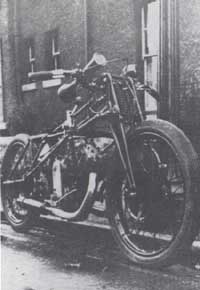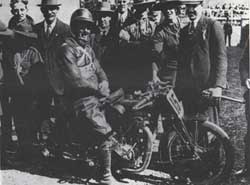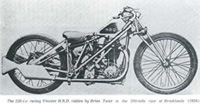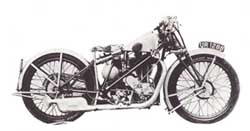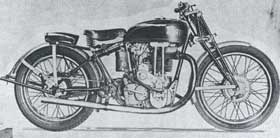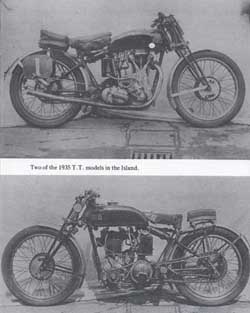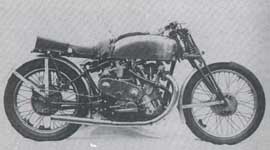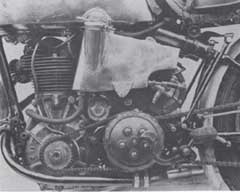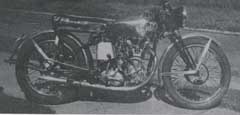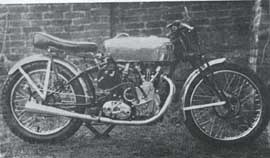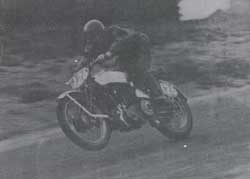|
Meteor and Comet Engine
When Phillip and his team returned from the island they were
so tired of J.A.P. engines that work was started on their
own design immediately, resulting in both Comet and Meteor
models being displayed in time for that year's Olympia Show
in October.
So, from 1935 onwards, Vincent racing motorcylces were fitted
with their own design of engine and Although they did not
win the 1935 TT they did at least manage a reasonable 7th
place.
It is worth pointing out though that J.A.P. engined bikes
were not totally absent in 1936, indeed the 11th and 13th
placed bikes in the Senior TT were such bikes, ridden by Manliffe
Barrington and L.Courtney, (see picture).
A customer version of the works racer was displayed that
year, the TT Model. This was fitted with a racing version
of their Comet engine, fitted with the higher lift 5x cams,
bronze head and a Burman 4 speed racing gearbox. A polished
stainless steel was an optional extra, costing an extra £1
over the normal price of £98 (see archive pictures).
This bike could be supplied in pure racing form or as a super
sports road model.
In 1936, like a number of manufacturers at that time, Vincent
decided to experiment with supercharging. The works racers
at that years Senior TT were fitted with Zoller superchargers,
or at least, they were in practice. Two of the 5 Vincent entries
were using superchargers, ridden by Jack Williams and Jock
Forbes, however, the unsupercharged bike of Jock West lapped
quicker, Added to this the supercharged machines were continually
overheating (due partly to fuel starvation!) and eventually
both riders reverted to unsupercharged machines. That was
about the end of it as far as supercharging went, except for
postwar specials of course!, however, the fact that they did
not work well was probably due as much as anything to them
being very much a 'rush job', without receiving the development
they needed to be successful.
Series B Racers and Twins
For 1937 the catalogue showed the racing version of the Comet
with a new name, the Series B T.T. Replica. This designation
was supposedly due to the large number of changes over the
previous years model but many of these were subtle and did
not change the bikes overall look,
For that year's Senior T.T. a 'works' team was again entered
by Phil Vincent but all 3 riders failed to finish. After this,
Phil Vincent declined any further involvement with the T.T.
races, believing the Isle of Man races had become too specialised
to be competative for production based bikes like his own.
In total only five Series B T.T, Replicas were made, and at
least one survives.
1936 heralded a major landmark in the history of Vincent
motorcycles, with the introduction of the immortal Rapide
1000cc V-Twin, the original 'Snarling Beast'. This bike was
based on 2 Meteor top half's mated to a common crankcase,
the prototype being mounted in a chassis originally built
for Eric Fernihough. From standard this machine was capable
of a genuine 100mph+, at a time when these speeds were almost
unheard of.
A single racing version of the twin was built, it being ridden
in anger at the Donington August Bank Holiday meeting by Ginger
Wood. Although the bike was not expected to do well against
the other nimbler works bikes, in fact it was able to shatter
the lap record, before retiring with clutch failure, the nemesis
of pre-war Vincent twins.
That was about it for racing Vincent's pre-war, like most
other motorcycle manufacturers, with the outbreak of hostilities
production moved away from bikes and more towards helping
the war effort. When production restarted, Vincent and Irving
were far more concerned about trying to put in production
a saleable production tourer, rather than racing bikes, so
it was not until 1948 that a production based racer was again
listed in the Vincent catalogue.
|
